Cover Photo provided by Mr. Jim Hartsell
Editor's note: When it came time to roll out our (long overdue) new website we wanted to do something celebrating the people we've met through golf and the places that are still out there for us to explore. We've only scratched the surface on who we need to meet and where we need to go. Jim Hartsell embodies that spirit to the fullest. I met Jim through Sweetens Cove a few years ago and we became fast friends. He's spent the last two-and-a-half decades exploring Scotland and digging deeper than nearly any American I know, non-Tom Coyne division. As an Registered Building Architect, he brings a unique perspective to golf travel, both on and off the course. We're thrilled to roll this series out over the next few months and hope you enjoy. - Tron
The Hidden Soul of the Game
Cruden Bay Golf Club, A Birthday Celebration
By Jim Hartsell
Much has changed since my first trip to Cruden Bay Golf Club in August of 1994. The course was then largely unknown to visiting American golfers, who ventured north of St. Andrews mainly to visit Royal Dornoch. I first learned about it from Michael Bamberger’s classic 1992 novel To The Linksland. In those days, there was a sense of adventure and discovery in traveling to what was one of the world’s greatest hidden gems. The welcome extended to visitors in the small, utilitarian white clubhouse was warm and sincere. The course - designed by the impressive combination of Old Tom Morris and Tom Simpson - was wild, fun and an altogether unique layout. I am happy to report that these things have not changed in the intervening 25 years. Cruden Bay remains one of the friendliest and most welcoming clubs in golf. While it has climbed high in the world rankings since 1994 - and can no longer be considered “hidden” - it is a course that must not be missed when visiting Scotland.

The Original Club House/Starters Hut at Cruden Bay. Photo provided by Mr. Jim Hartsell
Change, when it does come, does not proceed with haste in an ancient place like Scotland. Unlike Americans, Scots generally take a more measured approach when considering things like road infrastructure improvements, rightfully taking the time to consider all the effects on their beautiful country. The drive up from St. Andrews was not an easy one in 1994. Today it is made with relative ease, given the completion of the A90 bypass of Aberdeen. This new stretch of motorway has cut at least 30 minutes off the total drive time. Not that I recommend bypassing the famed granite city of Aberdeen, but time is precious on a Scottish golf trip. While you may feel a slight pang of regret as you head north on the A90 at Stonehaven - knowing you are only 2 minutes from that wild and wonderful clifftop golf course - difficult choices must be made. I urge you not to bypass a day at Cruden Bay when planning your dream golf trip.
Walking from the car park around the beautiful modern clubhouse (another change since 1994) you are suddenly confronted with a panorama of dunes and linksland that is unmatched. In the distance stands the impressive cliff top ruins of Slains Castle - the inspiration for Bram Stoker’s Dracula - as if additional enhancement of this glorious scene is necessary. It is the most stunning “reveal” in golf.
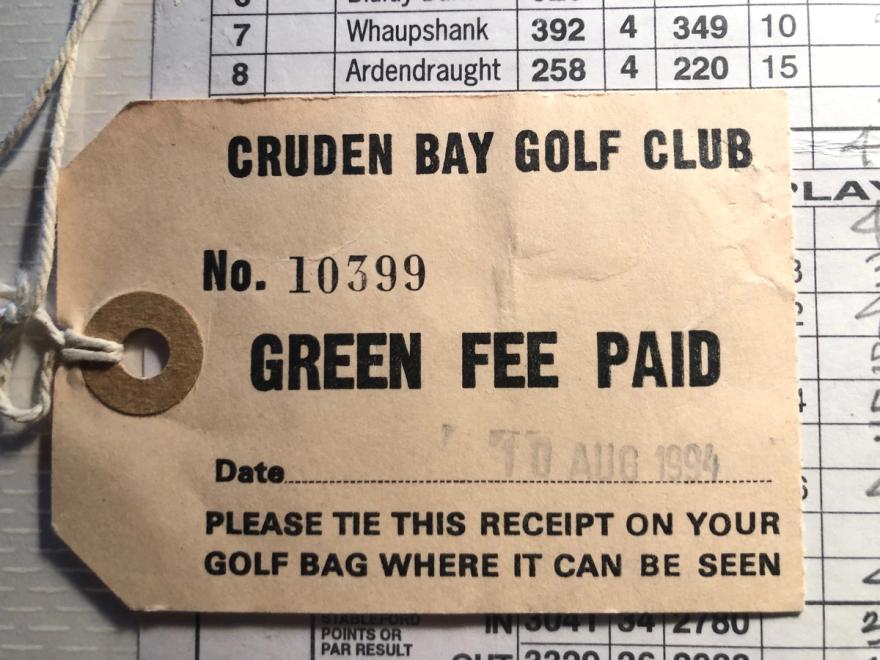
Jim's 1994 Cruden Bay bag tag. Photo provided by Mr. Jim Hartsell
It is believed that golf was played on this dramatic linksland as early as 1791. The genesis of the current links dates to 1894, when the Great North of Scotland Railway Company commissioned the course and a stunning hotel (sadly now demolished) to promote railway tourism. Old Tom Morris himself provided the initial routing. Cruden Bay Golf Club was founded in 1900. The current course layout dates to 1926 and is the work of noted English architect Tom Simpson.
As we arrived on a sunny May morning, the wind was already steady at 15 mph. Entering the brilliant pro shop (one of the best in Scotland) I was greeted warmly by Head Professional Neil Murray. Mr. Murray asked if I had played the course before. I explained that I had played it many times, but it had been almost 20 years since my last visit. “Well, you will find it much the same as you remember, except for the 9th and 10th. We built a new 9th hole a few years ago and relocated the tee on the 10th", said the friendly pro. I was soon to find out the stunning effect this seemingly minor change had made to the physical experience of playing Cruden Bay. We talked about my memories of the course, as I purchased several items from the well-stocked shop. I mentioned in passing that it was my son Jake’s first trip to Cruden Bay and it also happened to be his birthday. That off-hand comment led to one of the highlights of our entire trip.
The original clubhouse, one of my favorite buildings in Scotland, serves as the starter’s hut. At the time of our visit, it was being converted to a golf museum. The friendly starter greeted me and asked if an American called Chris could join our twosome, since it was his first visit to the course. I was happy to be a tour guide and found that I immediately remembered the correct lines off the tees - in spite of the almost 20 year gap in my experience. On almost every hole, there is an appropriate line that is most likely not readily apparent from the tee. One of the most joyous aspects of links golf is the strategy of where to land the ball on the ground. This is especially true on the tee shots at Cruden Bay. I think it may be the best “tee shot” course in the world.
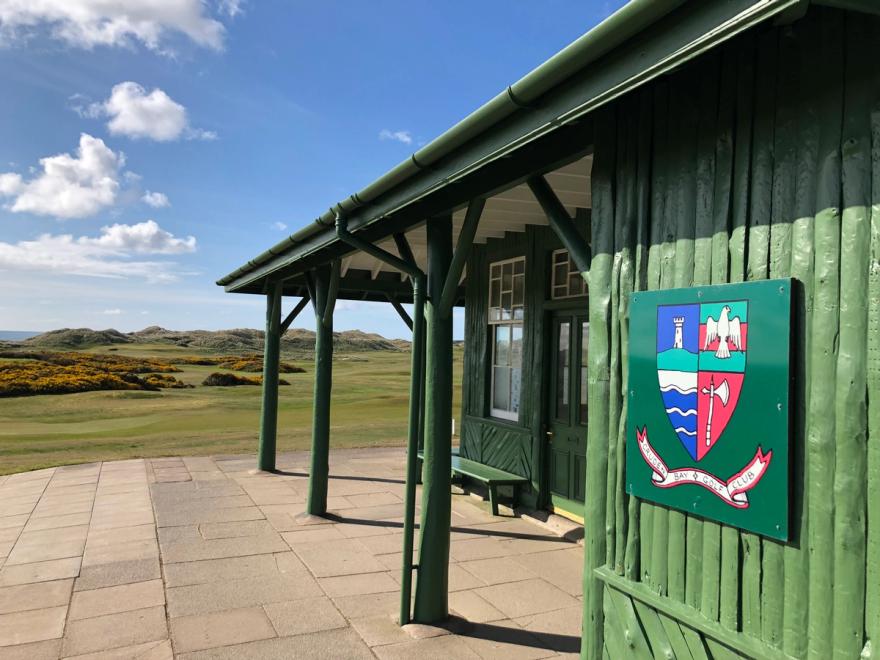
Original Clubhouse at Cruden Bay. Photo provided by Mr. Jim Hartsell
It’s difficult to think of a place that is more fun to play than Cruden Bay. The opening tee shot should favor the left side and must avoid a bunker, but in general does not cause excessive anxiety. The approach to the 2nd, to a dramatically raised plateau green, is one of the best approach shots on the course. At the 3rd, one of the great short par fours in the world, you start to enter the wild heart of the links. At 268 yards, the blind tee shot must land between dunes on both sides, which will funnel the ball down to the perfectly sited green. A well struck tee shot may result in an eagle try, but if you are too aggressive double bogey or worse is in play. This is a perfect golf hole.

3rd at Cruden Bay. Photo provided by Mr. Jim Hartsell
It would be natural to expect a let down after the sheer joy of the 3rd, but it is not to be. Quite simply, the 4th hole at Cruden Bay is one of the great par threes in golf. The tee is set behind the 3rd green, with the fishing village of Port Erroll and the river (called the Water of Cruden) to the left, and at 196 yards plays slightly uphill over a valley between the dunes and the river. The green sits perfectly among the massive dunes. Standing quietly on the 4th green at Cruden Bay, with the sound of the wind blowing through the grass covered dunes, it is impossible not to feel why Scotland is the true home of golf.

View of the 4th Cruden Bay. Photo provided by Mr. Jim Hartsell
Beginning with the tee shot at the 5th, you enter the most mighty and towering dunes in Scotland. The next 4 holes are routed masterfully through these sandhills. It does not matter if Old Tom or English Tom gets the majority of the credit, the holes are all memorable and great. The burn fronting the green on the par five 6th is a lovely - but devilish - wee stream that ensnares its fair share of golf balls.
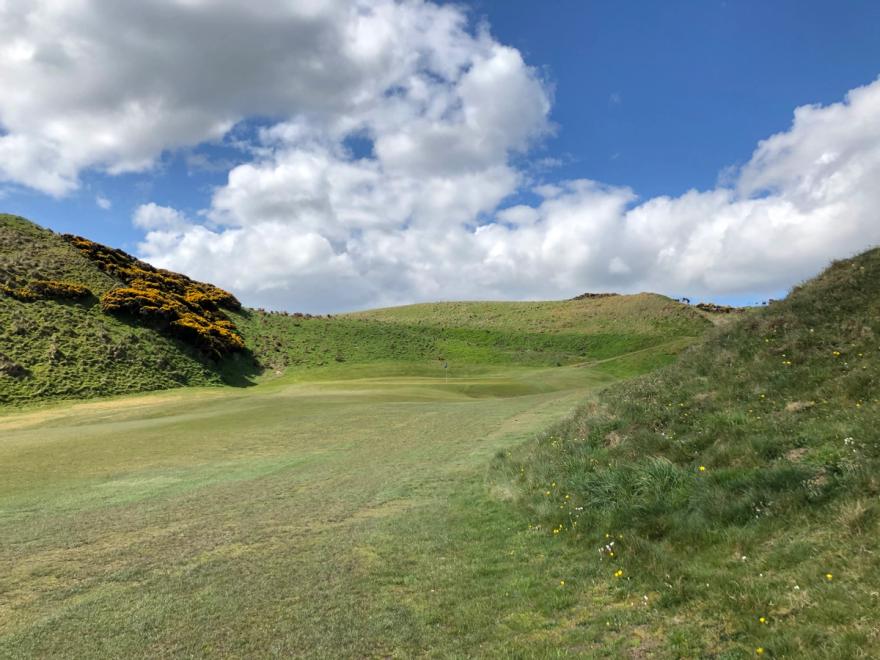
8th at Cruden Bay. Photo provided by Mr. Jim Hartsell
The 250 yard 8th is another drivable par 4, and is the physical and spiritual heart of the great links. Tom Simpson called the 8th "an outstanding jewel of a hole, mischievous, subtle and provocative, the element of luck with the tee shot being very high." It would be hard to argue with his assessment, even decades later. The 8th green does indeed sit like a jewel at the base of the towering gorse covered hills. Par in Scotland is in many ways irrelevant, but I love the fact that the 8th remains a par 4 and the club has never changed anything about the hole. In a lifetime of playing this game, it remains my favorite hole.
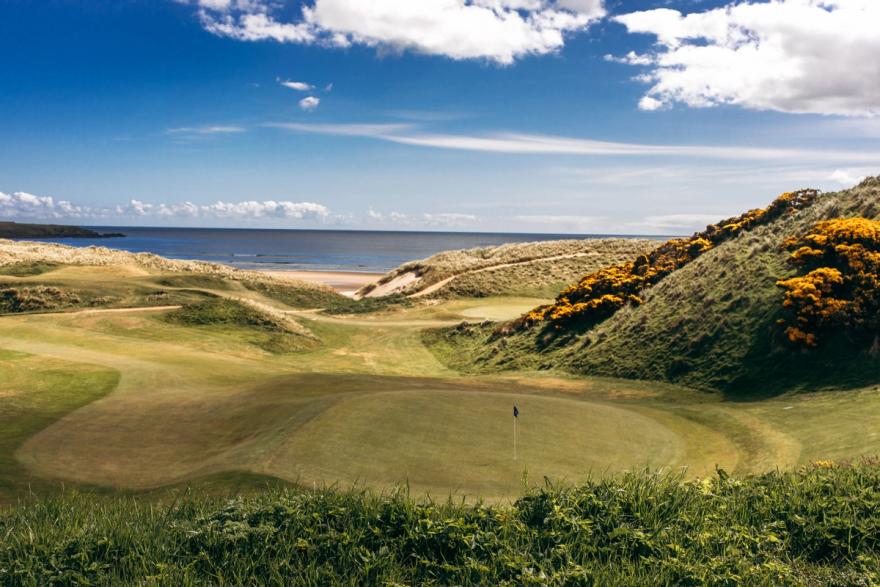
View from the 8th green at Cruden Bay. Photo provided by Mr. Jim Hartsell
The view from the 8th green across the 16th hole, to the beach and ocean beyond, is stunning. As you make the steep ascent to the new 9th tee -to what may be the metaphysical summit of golf - it becomes apparent that the prior view at the 8th was only a prelude of the vista to come. The climb to the 9th tee at Cruden Bay is one of the more arduous I’ve ever encountered. However, the reward more than compensates for our momentary struggles. A few years ago, in an altogether brilliant design move, the 9th hole was shifted around 100 yards to the east, right along the very edge of the highest point on the grounds. As a result, a formerly average par four (by Cruden Bay standards) was transformed into one of the great par fours in golf. In my view - along with the 17th green at the Old Course, the 8th green at Machrihanish and the 11th tee at Dunaverty - the 9th tee at Cruden Bay is one the the spiritual epicenters of the game. You can’t help but take in the unparalleled view for several minutes, most likely in stunned silence. The details are always perfect in Scotland, so there is a bench by the tee to assist in your recovery from the climb.
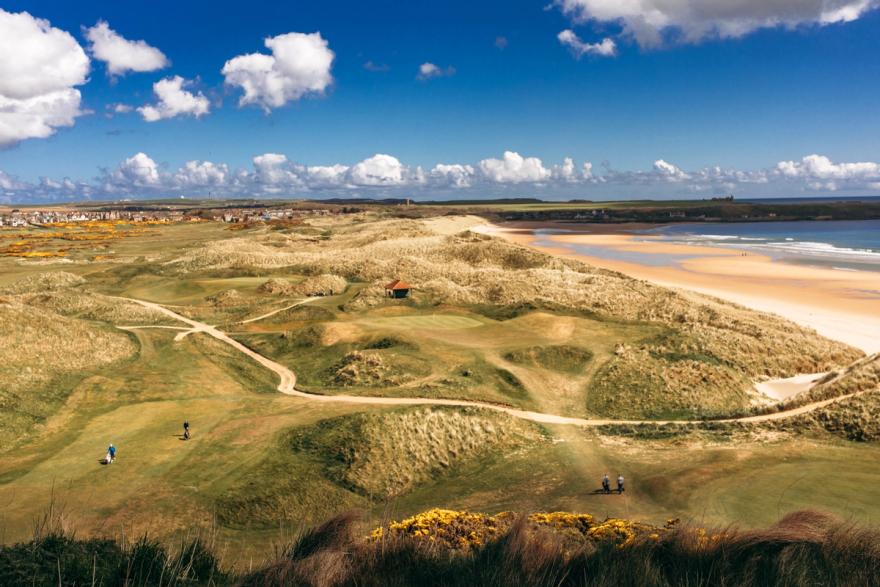
8th fairway with 16th green. Photo provided by Mr. Jim Hartsell
When the new 9th hole was created, the 10th tee was moved about 50 yards to the west. As an added benefit, this has made the 10th a much better hole. Driving from the heights of the new 10th tee to the valley floor below is a great thrill. It is a wonderful and testing par 4, in what is likely to be a strong crosswind. The 11th is a nice par three - and almost a certain bogey - if the green is not reached on the tee shot. The 12th is a good par four, but thought by many to be the weak link in a stretch of otherwise incomparable golf holes. As we putted out on 12, I noticed what appeared to be another green in the distance, set against the impossibly blue ocean. This hidden green was an addition since my prior visits. I made a mental note to try to find out more about it.
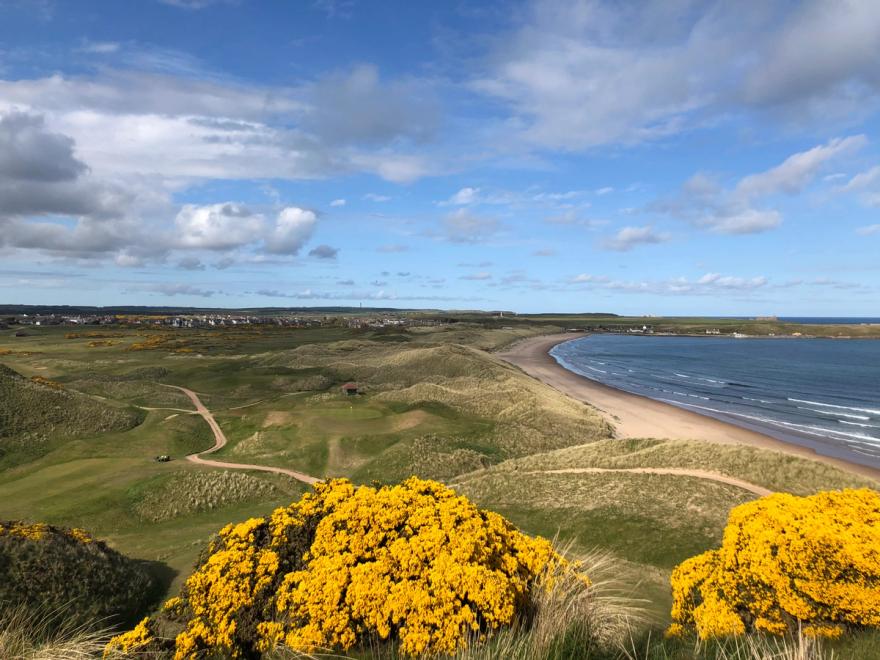
View from the 9th tee at Cruden Bay. Photo provided by Mr. Jim Hartsell
The 13th runs along the ocean and is a truly great par five. The tee shot must avoid the winding burn and high grass along the beach. The 2nd shot should be played to the left side of the fairway to open up the approach into the massive green, which lies at the base of the dune mountain from which we have just recently descended.

View of 13 and 14 from the 9th tee. Photo provided by Mr. Jim Hartsell
Whins, the 14th, is another singular hole in my golfing experience. The tee shot is played blind, from an elevated tee hard by the beach, to a fairway that appears non-existent. The aforementioned gorse covered dune is there to destroy any tee shot that has, as the great Prestwick caddie Chris McBride says, “Left-wing tendencies.” If the relative safety of the fairway is reached, one of the great blind approach shots of the world awaits. The almost rectangular shaped green is located over a dune down in a sunken pit, at least 15 feet below surrounding grade. I don’t know of any other green site like this anywhere in the world. If you don’t have a smile on your face after playing this hole, then you probably shouldn’t be playing golf at Cruden Bay.

14th green at Cruden Bay. Photo provided by Mr. Jim Hartsell
I have always viewed the 15th and 16th as two sides of the same coin. Back to back par threes, they continue the glorious madness that Old Tom and Tom Simpson have so thoroughly maintained for 14 holes. The 195 yard 15th is played over the end corner of the ever-present mountainous dune, blind and dog-legged, to a green which we can only trust is out there somewhere. I have hit everything from a full driver to a 9 iron on this hole. It is madness and sheer fun. The 16th finally breaks us free of the great dune’s clutches and is somewhat more conventional. It is played from an elevated tee to a beautiful green site set amongst the dunes. I once made a 13 on this hole in a 40 mph crosswind, en-route to a score of 106, with tee shot after tee shot flying wildly onto the beach. The very next morning I had a tap-in birdie 2, on the way to a handy 75. That is links golf in a nutshell.
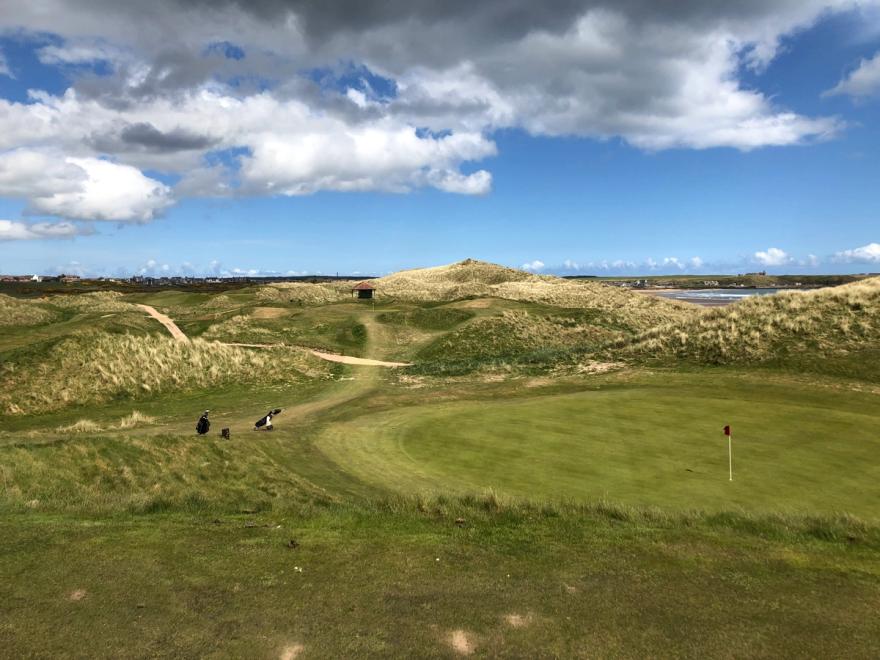
15 and 16 at Cruden Bay. Photo provided by Mr. Jim Hartsell
The 17th and 18th are good holes, though not as good as their predecessors, and serve admirably to take us out of the mighty duneland back to the welcoming confines of the clubhouse bar. The tee shot on the 17th must avoid an unusual grass covered mound in the middle of the fairway, thought to be the burial ground of Scots and Danes killed in a battle in the year 1012. Is the story true? I don’t know and honestly don’t care. I choose to believe it is. The tee shot on the 18th should favor the left for the best angle into the green, but out of bounds lurks along that entire side. We shook the hand of our new friend Chris and invited him to join us for lunch in the clubhouse bar.
Not enough can be said about the hospitality shown to us by the staff at Cruden Bay. It is something I will never forget. We had a wonderful and delicious lunch, complete with the requisite pint of Tennents. As we were finishing up our meal, the strains of the Happy Birthday song started to play over the sound system. Somehow the bar staff had also managed to insert Jake’s name into the song, as the dining room manager came out to our table with a shortbread and strawberry cake complete with a birthday candle.

Lunch at Cruden Bay. Photo provided by Mr. Jim Hartsell
Les Durno, the great General Manager, came out along with the cake and introduced himself. A man who obviously loves Cruden Bay, we immediately struck up a conversation about the history of the course, the old railway hotel, and the brilliant changes to the 9th and 10th. I mentioned that I thought the new 9th hole had put Cruden Bay at an even higher level in the golf world. “Aye, it has indeed. I remember walking out into the gorse with the architect on his first visit. You could see what a great hole it would be before we even started work. It’s been a brilliant change to the course.” Curious about the hidden green I had seen behind the 12th, I asked Les about it. A smile lit up his face, “Ah, yes. That’s the alternate 12th hole. We play it in the winter. There are some that would love to make it a permanent hole, with some possible reworking of the 11th and 12th. You should play it when you go back out this afternoon. The wee tee is up in the dunes to the right.” We played the alternate 12th hole in the afternoon and it is a delightful par three. I can see why some members prefer it.

Birthday Cake at Cruden Bay. Photo provided by Mr. Jim Hartsell
Les and I continued our splendid conversation for several more minutes, with the old clubhouse and railway hotel as a major topic. He then took me to meet the wonderful long time booking secretary Elaine Stephens, who I remembered talking to on the phone all those years ago in 1994. We spoke briefly about the old days of fax machines and actual written letters for booking golf reservations. As I was leaving to join my son for the afternoon round (with two complimentary drams of Cruden Bay whisky), Elaine said kindly, “I am so pleased you made it back to Cruden Bay.”
Aye, I am too.
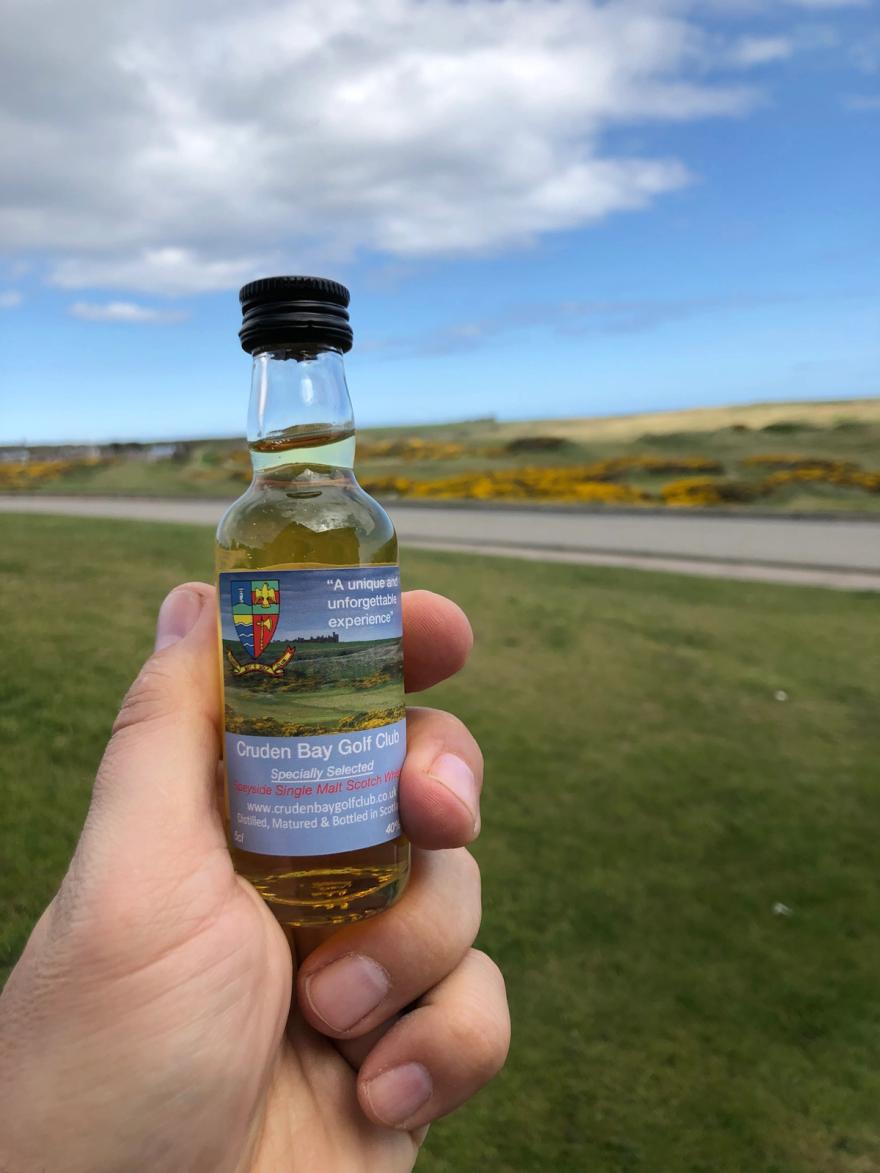
Whiskey at Cruden Bay. Photo provided by Mr. Jim Hartsell
Recommendations
I may begin to sound a bit repetitive, but the food in the Cruden Bay clubhouse is excellent. You cannot go wrong eating lunch or your evening meal there - with the added bonus of one the greatest clubhouse views on the planet.
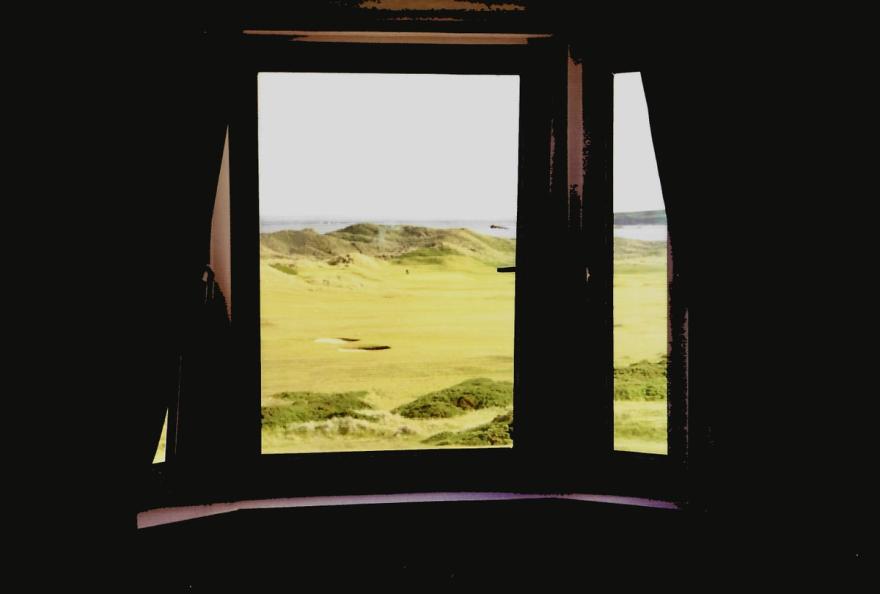
Room view from Cruden Bay Bed & Breakfast. Photo provided by Mr. Jim Hartsell
One of my favorite hotels of all-time, The Red House Hotel in Cruden Bay is now called the Cruden Bay Bed & Breakfast. The excellent restaurant that served The Red House is no longer open, but Ian Devenish still runs the B&B and I am sure the welcome remains one of the best in Scotland. Stay in Room #4 and you will be presented with an unmatched view of the mighty links - many late evenings I have sat silently with a whisky in that bay window.
I have also stayed in the Kilmarnock Arms Hotel. It is a favorite of visiting golfers and highly recommended. It has a nice bar and excellent restaurant.
The nearby city of Peterhead has many lodging and dining options and is an easy 10 minute drive after a round at Cruden Bay. I have played the links at Peterhead GC and it is worth adding to your itinerary, if you have the time.